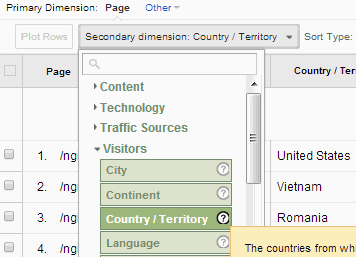Secondary Dimension in Google Analytics: Finest Practices and Tips
Secondary Dimension in Google Analytics: Finest Practices and Tips
Blog Article
Enhance Your Information Analysis Making Use Of Additional Dimension in Google Analytics
Discovering the capabilities of additional measurements in Google Analytics opens up a realm of possibilities for refining information evaluation. By layering extra measurements onto main data collections, a more intricate narrative arises, dropping light on user interactions and performance signs.
Understanding Second Dimensions
In the world of data evaluation, a critical aspect to grasp is the principle of secondary measurements and their relevance in removing deeper understandings from Google Analytics records. Second dimensions in Google Analytics describe added criteria that can be contributed to the main measurement, enabling an extra in-depth evaluation of data. By integrating secondary measurements, experts can segment and filter information to uncover patterns, trends, and relationships that may not be apparent when looking at the information overall. These secondary dimensions can supply context and a more detailed understanding of individual actions, web traffic sources, and various other crucial metrics tracked by Google Analytics.

Benefits of Utilizing Second Dimensions
When evaluating data in Google Analytics, the application of additional measurements offers important understandings into customer behavior and efficiency metrics. By including a second dimension to your main data, you can dive much deeper right into the qualities of your internet site site visitors and their interactions. Among the crucial benefits of making use of secondary measurements is the capability to segment and contrast information better. This segmentation permits you to understand exactly how different variables, such as demographics or website traffic resources, impact customer habits and conversions (Secondary Dimension in Google Analytics).
Additionally, second dimensions help in recognizing patterns and relationships that might not be immediately apparent when taking a look at the information in seclusion. This much deeper level of evaluation can reveal beneficial details that can guide advertising and marketing techniques, site optimization, and overall organization decisions. Furthermore, additional measurements improve the context of your key information, offering a much more extensive view of individual involvement and performance metrics. On the whole, the usage of additional dimensions in Google Analytics can dramatically improve the deepness and top quality of your data evaluation, causing even more this contact form informed decision-making and enhanced outcomes.
Just How to Include Secondary Dimensions
By including secondary dimensions in Google Analytics, users can gain deeper understandings right into their information evaluation process, enabling for even more comprehensive examination of customer behavior and performance metrics. Including secondary dimensions is a simple procedure that can dramatically boost the deepness of analysis. As soon as in the report, find the "Secondary dimension" tab over the data table.
Studying Data With Additional Measurements
Utilizing second dimensions in information analysis offers an extra comprehensive understanding of customer habits and efficiency metrics. By including a second measurement to your main information embeded in Google Analytics, you can dig deeper right into the features of your site site visitors and their communications. Incorporating the primary measurement of 'source/medium' with the secondary measurement of 'landing page' can expose which certain pages are drawing in website traffic from different resources, aiding you maximize these pages for far better engagement.

Essentially, evaluating information with additional dimensions equips you to get useful insights right into customer habits, recognize patterns, and make notified decisions to improve the performance of your digital residential or commercial properties.
Finest Practices for Additional Measurements
In data evaluation, including secondary dimensions successfully can considerably enhance the depth of insights originated from metrics and customer actions patterns. When making use of additional measurements in Google Analytics or any other logical tool, it is essential to comply with ideal techniques to make sure the accuracy and significance of the data analysis.
One key finest technique is to meticulously select second dimensions that enhance the primary dimension being examined. Choosing secondary measurements that offer additional context or further segmentation can offer a more comprehensive understanding of the data. It is additionally necessary to prevent overcomplicating the evaluation by including a lot of second dimensions, which might cause confusion or dilution of understandings.
Moreover, it is recommended to explore different combinations of key and second dimensions to discover new connections and trends. Consistently evaluating and refining have a peek at this site the choice of secondary dimensions based upon the particular goals of the analysis can cause even more workable understandings. By following these best practices, information experts can leverage additional measurements efficiently to boost the general data evaluation process and decision-making abilities.

Verdict
Finally, including additional dimensions in Google Analytics is essential for a comprehensive information evaluation strategy. By leveraging secondary measurements along with primary ones, marketing experts and experts can reveal beneficial Our site insights and connections that can inform decision-making and enhance digital advertising and marketing methods. Comprehending how to successfully utilize secondary dimensions and adhering to best techniques will enable professionals to extract significant information and improve their overall efficiency metrics.
Secondary dimensions in Google Analytics refer to additional criteria that can be included to the key dimension, enabling for a more in-depth analysis of information. By integrating second measurements, analysts can sector and filter data to reveal patterns, patterns, and relationships that may not be apparent when looking at the data as a whole. Integrating the main measurement of 'source/medium' with the additional measurement of 'touchdown page' can reveal which details web pages are attracting traffic from different resources, aiding you enhance these pages for far better interaction.
One secret finest technique is to meticulously pick second dimensions that complement the key dimension being evaluated. By complying with these finest practices, data analysts can leverage additional measurements successfully to boost the overall data analysis procedure and decision-making abilities.
Report this page